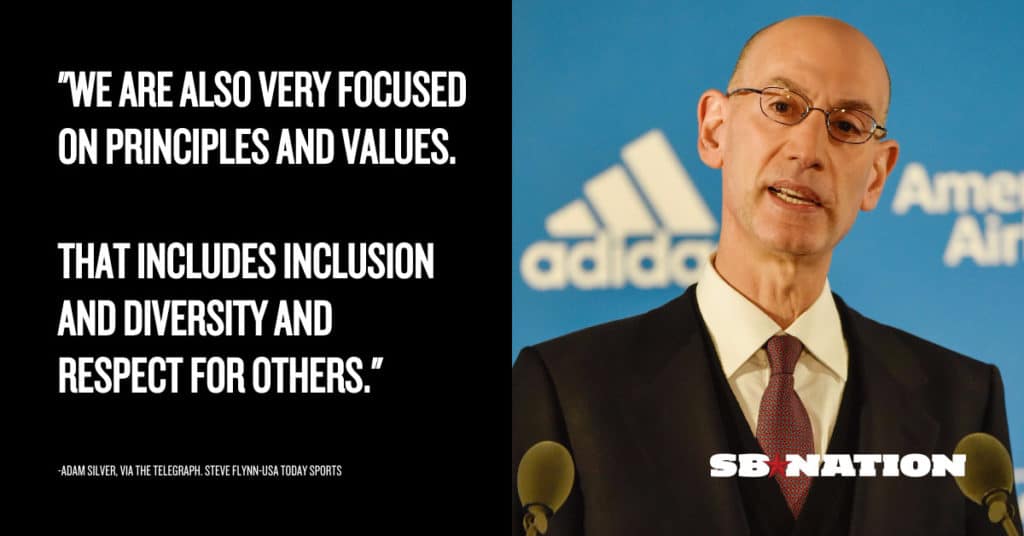As an avid sports fan and someone who actively works with business leaders to help them understand the importance and impact of diversity and inclusion (D&I) as a cultural norm, I am impressed with NBA Commissioner, Adam Silver. Silver is promoting the conversation and driving D&I as a core competency in the league he oversees.
Lately, the topic of diversity has been front and center in professional sports and was once again on display during the NBA’s opening night. Prior to last week’s marquee opening game between the Cleveland Cavaliers and the Boston Celtics, NBA Commissioner Adam Silver took an opportunity to proactively and constructively communicate expectations. He sent a letter to each team giving an order to stand for the National Anthem, but offered players the option to address the crowd to share their opinion on diversity and inclusion.
Diversity is any dimension that can be used to differentiate groups and people from one another, including perspectives, work experiences, life styles and cultures. Inclusion is a state of being valued, respected and supported. It’s about focusing on the needs of every individual and ensuring the right conditions are in place for each person to achieve his or her full potential. In simple terms, diversity is the mix; inclusion is getting the mix to work well together.
Although Silver’s words on opening night were likely overshadowed by Gordon Hayward’s horrifying ankle fracture, his message continues to be both powerful and more proactively handled than the way this conversation has been playing out in the NFL.
“They [the players] represent the very best values in all of sports and all of life – inclusion, diversity, leadership and character,” Silver said before the game. He has also been quoted recently that he is “proud of our players for taking an active role in their communities and to speak out on critically important issues.”
Over the past few months Silver has been confronted with a series of highly visible situations underscoring the diversity conversation, including President Trump’s break with tradition by revoking his White House invitation to last year’s NBA champion, the Golden State Warriors ; the heated comments from San Antonio’s outspoken Coach Greg Popovich referring to President Trump is a “soulless coward;” and LeBron James wearing customized sneakers for the season-opener with the word “equality” stitched on them and further remarking that “not one individual, no matter if it’s the President of the United States…can stop one’s dreams from becoming a reality.” Rather than attempting to control the conversation, Silver continues to encourage the league’s players to speak out through social media where they seemingly are uninhibited and mingle with their supporters. It gives them direct access to their fans and ability to share their personal interests. The NBA recognizes that active presence on social media by its players makes the league ratings higher and brand stronger.
In our work with organizations, we have found two distinct types of leaders – those who are “awake” with eyes wide open and those who are not. Awake leaders realize that diversity is a source and driver of innovation and a differentiating core competency. They strive to integrate inclusion in their organization’s culture, practices and relationships to support their diverse workforce. The other distinct type of leader is one who is asleep, or unwilling to address the work it takes to promote diversity and inclusion of talent and thought. I see Silver as a wide – awake leader. His approach to the topic and the surrounding public discourse, by actually leaning in on the issue, is admirable. The NBA continues to set the standard for diversity among major professional sports leagues and I believe is a model for others to emulate.
When we draw on the wisdom of a workforce that reflects the population we serve, we are better able to understand and meet the needs of our customers. But merely recruiting a diverse workforce is not enough. Organizations must foster the culture of inclusion to reap the greatest rewards. The business case for inclusion is clear in American history. The best, brightest, and hardest workers have come to America for over two centuries because they knew they would have an opportunity to join our society, work hard, and succeed.
By evaluating your current business practices, you can make sure that your workplace is inclusive and attracts and retains diverse talent. See how Exude can help.
